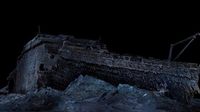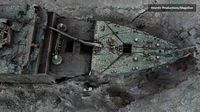In a groundbreaking digital analysis, the final hours of the Titanic are being reexamined with unprecedented detail, shedding light on the tragic events of April 14, 1912. A new documentary titled Titanic: The Digital Resurrection, produced by National Geographic, showcases a 3D digital twin of the ill-fated ship, offering insights into its sinking that have eluded historians for over a century.
The Titanic, which sank after striking an iceberg, resulted in the loss of approximately 1,500 lives that fateful night. The wreck now lies 3,800 meters beneath the icy waters of the North Atlantic, where it has remained for over a century, slowly revealing its secrets.
According to Parks Stephenson, a Titanic wreck analyst, "The Titanic is the last eyewitness of the disaster, and it still has stories to tell." This sentiment is echoed in the documentary, which utilizes advanced digital algorithms, computer modeling, and over 700,000 images to create a detailed reconstruction of the ship and its demise.
One of the most significant revelations from this digital exploration is the condition of the ship's hull at the time of impact. The simulations indicate that the Titanic's hull only grazed the iceberg, with damage that was surprisingly minimal—tiny perforations no larger than a sheet of paper. Simon Benson, a naval architecture lecturer at Newcastle University, explained, "The difference between the Titanic sinking and not sinking comes down to holes the size of a sheet of paper." This revelation underscores the Titanic's design flaws, as it was originally believed to be unsinkable.
As the digital twin of the Titanic was created, researchers were able to confirm several eyewitness accounts from survivors. Notably, the analysis of the boiler room revealed that engineers worked tirelessly until the end to keep the lights on for the crew and passengers. Stephenson noted, "They maintained the lights and electricity until the end to give the crew time to launch the lifeboats safely, with a little light rather than in absolute darkness." This act of bravery highlights the desperate attempts made by the crew to save lives amid the chaos.
Interestingly, the digital scan has also identified a possible broken porthole that may have been caused by the iceberg during the collision. This detail adds another layer of understanding to the events that unfolded that night, as ice reportedly infiltrated some cabins at the moment of impact.
The Titanic was designed to remain afloat with up to four compartments flooded, but the damage inflicted by the iceberg extended across six compartments, leading to its eventual sinking. "The ship was designed to withstand four flooded compartments, but not five," Benson reiterated, emphasizing the catastrophic impact of those tiny holes.
As the documentary prepares for release, it promises to provide a comprehensive view of the Titanic's last moments, combining historical accounts with cutting-edge technology to create a narrative that is both informative and poignant.
In the wake of the Titanic's sinking, the maritime industry underwent significant changes, with improved safety regulations and practices implemented to prevent such tragedies from occurring again. The lessons learned from this disaster continue to resonate in the field of naval architecture and maritime safety.
Reflecting on the Titanic's legacy, many experts agree that the tragedy serves as a reminder of the limits of human engineering and the unpredictable forces of nature. The digital resurrection of the Titanic not only honors those who lost their lives but also ensures that their stories will continue to be told for generations to come.
As the world looks back on the events of April 14, 1912, the ongoing exploration of the Titanic's wreckage offers new insights and a deeper understanding of one of history's most infamous maritime disasters. The combination of technology and historical inquiry promises to keep the memory of the Titanic alive, illuminating the past while paving the way for future advancements in maritime safety.





